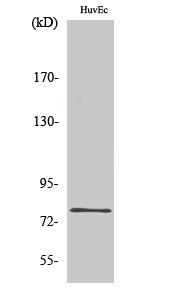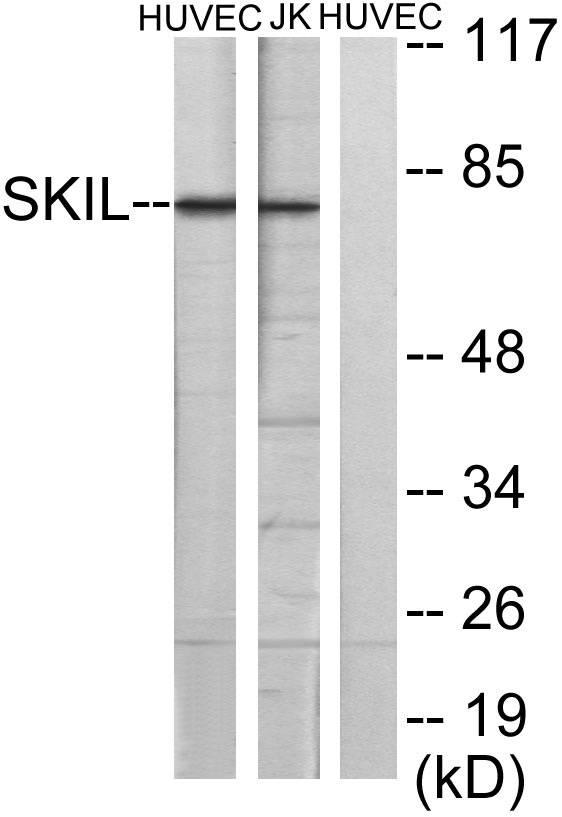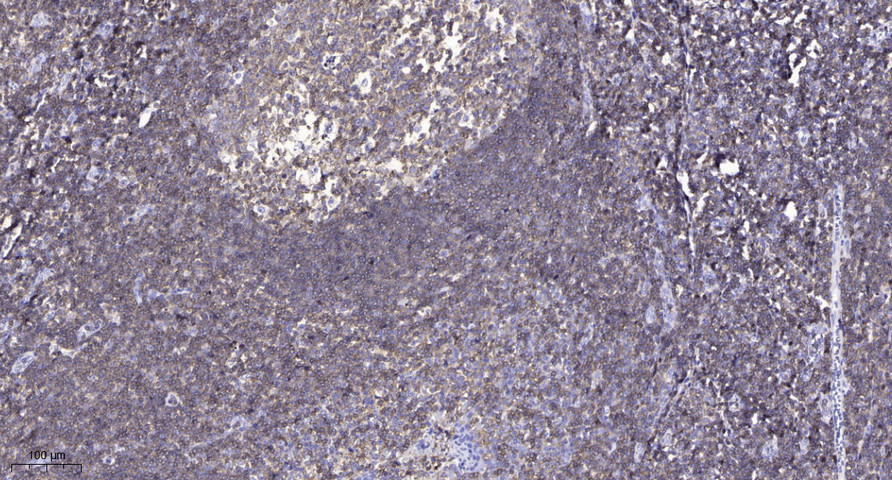SnoN Polyclonal Antibody
- Catalog No.:YT4356
- Applications:WB;IHC;IF;ELISA
- Reactivity:Human;Mouse
- Target:
- SnoN
- Fields:
- >>Signaling pathways regulating pluripotency of stem cells
- Gene Name:
- SKIL
- Protein Name:
- Ski-like protein
- Human Gene Id:
- 6498
- Human Swiss Prot No:
- P12757
- Mouse Gene Id:
- 20482
- Mouse Swiss Prot No:
- Q60665
- Immunogen:
- The antiserum was produced against synthesized peptide derived from human SKIL. AA range:616-665
- Specificity:
- SnoN Polyclonal Antibody detects endogenous levels of SnoN protein.
- Formulation:
- Liquid in PBS containing 50% glycerol, 0.5% BSA and 0.02% sodium azide.
- Source:
- Polyclonal, Rabbit,IgG
- Dilution:
- WB 1:500 - 1:2000. IHC 1:100 - 1:300. ELISA: 1:40000.. IF 1:50-200
- Purification:
- The antibody was affinity-purified from rabbit antiserum by affinity-chromatography using epitope-specific immunogen.
- Concentration:
- 1 mg/ml
- Storage Stability:
- -15°C to -25°C/1 year(Do not lower than -25°C)
- Other Name:
- SKIL;SNO;Ski-like protein;Ski-related oncogene;Ski-related protein
- Observed Band(KD):
- 77kD
- Background:
- The protein encoded by this gene is a component of the SMAD pathway, which regulates cell growth and differentiation through transforming growth factor-beta (TGFB). In the absence of ligand, the encoded protein binds to the promoter region of TGFB-responsive genes and recruits a nuclear repressor complex. TGFB signaling causes SMAD3 to enter the nucleus and degrade this protein, allowing these genes to be activated. Four transcript variants encoding three different isoforms have been found for this gene. [provided by RefSeq, Oct 2011],
- Function:
- function:May have regulatory role in cell division or differentiation in response to extracellular signals.,similarity:Belongs to the SKI family.,subunit:Interacts with SMAD2, SMAD3 and RNF111.,tissue specificity:SNON and SNOA isoforms are widely expressed. Highest expression is found in skeletal muscle, followed by placenta and lung. Lowest expression in heart, brain and pancreas. Expression of isoform SNOI is restricted to skeletal muscle.,
- Subcellular Location:
- acrosomal vesicle,nucleus,nucleoplasm,transcription factor complex,cytoplasm,PML body,transcriptional repressor complex,protein complex,
- Expression:
- Isoform SNON and isoform SNOA are widely expressed. Highest expression is found in skeletal muscle, followed by placenta and lung. Lowest expression in heart, brain and pancreas. Isoform SNOI expression is restricted to skeletal muscle.
- June 19-2018
- WESTERN IMMUNOBLOTTING PROTOCOL
- June 19-2018
- IMMUNOHISTOCHEMISTRY-PARAFFIN PROTOCOL
- June 19-2018
- IMMUNOFLUORESCENCE PROTOCOL
- September 08-2020
- FLOW-CYTOMEYRT-PROTOCOL
- May 20-2022
- Cell-Based ELISA│解您多样本WB检测之困扰
- July 13-2018
- CELL-BASED-ELISA-PROTOCOL-FOR-ACETYL-PROTEIN
- July 13-2018
- CELL-BASED-ELISA-PROTOCOL-FOR-PHOSPHO-PROTEIN
- July 13-2018
- Antibody-FAQs
- Products Images

- Western Blot analysis of various cells using SnoN Polyclonal Antibody diluted at 1:1000 cells nucleus extracted by Minute TM Cytoplasmic and Nuclear Fractionation kit (SC-003,Inventbiotech,MN,USA).

- Western blot analysis of lysates from HUVEC and Jurkat cells, using SKIL Antibody. The lane on the right is blocked with the synthesized peptide.

- Immunohistochemical analysis of paraffin-embedded human tonsil. 1, Antibody was diluted at 1:200(4° overnight). 2, Tris-EDTA,pH9.0 was used for antigen retrieval. 3,Secondary antibody was diluted at 1:200(room temperature, 45min).


